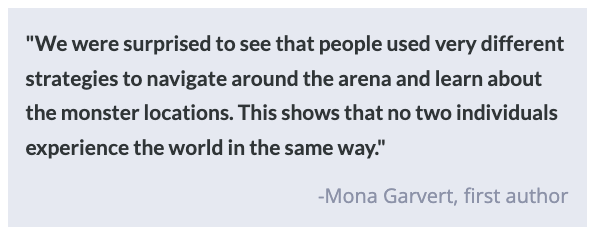Using Virtual Reality to Probe Human Spatial Learning and Decision Making
Post by Anastasia Sares
The takeaway
Using a virtual reality environment and fMRI, researchers can study human navigation and how we can learn what is rewarding in our environment. This article shows how the orbitofrontal cortex, a region located in the frontal lobe just above the eyes, interacts with our hippocampus (the brain’s map-making region) in situations where knowledge about our surroundings can help when we face new decisions.
What's the science?
One of the difficulties in trying to understand how humans learn about objects in their environment is that objects close to each other in space also tend to be close to each other in time. That is, as we explore spaces, we tend to encounter close-by objects sooner and far-away objects later. However, since everyone navigates their environment in slightly different ways, they experience their own unique sequence of events while reconstructing the same space in their head.
This week in Nature Neuroscience, Garvert and colleagues designed a virtual reality experiment to pull apart the time and space aspects of our navigational abilities and to show what happens when one of those dimensions (here: space) can inform new decisions.
How did they do it?
The authors conducted a three-day experiment where participants learned their way around a virtual arena with monsters in it; the knowledge they acquired in the arena could later be used to maximize rewards.
On day 1, participants started by exploring the arena, which had some landmarks around the edge, and hidden monsters scattered about (they would not appear until the person “walked” to just the right position). The goal on the first day was just to memorize the locations of the monsters. After exploring, participants were tested by walking to the locations of the monsters they were tasked to find.
On day 2, participants had some additional practice and were put into the functional magnetic resonance imaging (fMRI) scanner. While their brains were scanned, they viewed images of the monsters and were encouraged to think about their location in the arena. Sometimes, two monsters would appear, and they would have to choose the one whose location was closest to the monster presented previously. This allowed the researchers to investigate how the monsters were represented in the brain.
On day 3, participants practiced locating the monsters again and entered the scanner for a second time. This time, they were presented with pairs of monsters and told to select the one with a higher reward, knowing that monsters that lived in close proximity would be worth a similar number of points. Points were presented after they made their choice on each trial. In reality, monsters close to a certain point in the arena were worth more points, and those further away were worth less. At the end of the choice task, participants were presented with two monsters whose reward value had never been shown in the choice task and asked to predict the reward value. Participants could successfully do this, demonstrating that they used knowledge about the monster locations to predict unseen rewards. Finally, participants completed the viewing task again, just like they had on day 2, this time thinking about both the spatial location and reward value of each monster.
What did they find?
Participants had a variety of exploration strategies in the virtual environment, and thus each person visited the monsters in a unique order.
However, in the choice task, the spatial relationships and not the order in which they saw the monsters could be used to maximize rewards. The authors compared different models to see which best explained the participants’ choices: one that relied only on predictions based on spatial relationships, one that relied on predictions from that person’s exploration order, and one that combined both. It was the “both” model that ended up making the best predictions. People use a combination of time (the order of their experiences) and space (the map representations they have built) to represent the relationship between two objects. Some people leaned more towards spatial relationships and were better at updating them, while others relied more on the order in which they had experienced things.
This was also true in the brain. The team focused on the hippocampus, a region that is known to help us make cognitive maps and navigate our environment. The authors were able to use activity in this region to predict how much people used their knowledge about the relative distances between monsters to infer the values of monsters whose values they had not experienced, yet, on day 3. So, this region is likely involved in helping people generalize about properties of their environment such as whether it’s rewarding or not. However, it was not the only brain region involved: activity in the orbitofrontal cortex was related to the participant’s ability to update and refine their strategy, focusing on spatial aspects to get the optimal reward. This is a neat confirmation of a similar animal-based result in a recent brainpost.
What's the impact?
Learning to navigate to rewards is a crucial skill for any animal’s survival—we must have maps to rewards like food sources or safe places to sleep. The interaction of the hippocampus and the orbitofrontal cortex seems to be key to this skill, now being shown in both animals and in humans.



